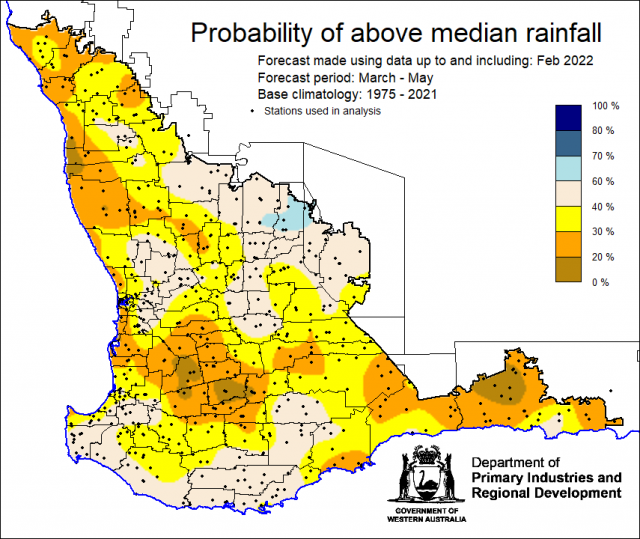Summary
The Department of Primary Industries and Regional Development’s (DPIRD) Statistical Seasonal Forecast (SSF) outlook for autumn, March to May 2022 is indicating less than 40% chance of exceeding median rainfall for the majority of the South West Land Division (SWLD).
- For autumn, March to May 2022, the SSF is indicating less than 40% chance of exceeding median rainfall for the majority of the SWLD. With neutral chances for other parts and above 60% chance for parts of the shire of Mount Marshall. The most probable rainfall decile map indicates decile 2-3 for the majority of the SWLD and decile 8-10 for parts of Mount Marshall, Mukinbudin and Westonia shires. Predictive skill based on February conditions is mostly poor (50-70% consistent).
- The Bureau of Meteorology’s seasonal outlook for autumn, March to May 2022 is indicating neutral (40-60%) chance of above median rainfall for the SWLD. Predictive skill is poor to moderate (45-65% consistent). The longer term outlook for April to June 2022 is the same (40-60%), with better skill (45-75%).
- Temperature outlooks for autumn, March to May 2022, from the Bureau indicate a 60-80% chance of above average day-time maxima, with the higher chances along the coast. Skill is 65-100%. The Bureau, indicates 70- 80% chance of exceeding above average night-time minima for the SWLD, with the higher chances along the coast. Skill is 45-65%.
- February rainfall was generally below average to average for the SWLD. February maximum temperatures were very much above average for the SWLD. Minimum temperatures were above average.
- The main climate driver influencing Australia rainfall is the La Niña in the Pacific, which is past its peak. La Niña increases the likelihood of tropical cyclones within the Australian region. The Southern Annular Mode is currently positive, but has little influence on rainfall at this time of the year, however increases temperature as there are fewer westerly winds.
- Autumn is the ‘predictability barrier’ for forecasting ENSO, so models are at their lowest skill.
Three Month Outlook for the south-west of Western Australia
Statistical Seasonal Forecasting (SSF)
DPIRD’s Statistical Seasonal Forecast (SSF) system uses historical relationships between global sea surface temperature and sea level pressure with rainfall in south-west Australia to produce forecasts of rainfall for the coming months. Users can click on any station indicated on the map for location-specific forecast information from DPIRD’s Seasonal Climate Information pages.
For autumn, March to May 2022, the SSF is indicating less than 40% chance of exceeding median rainfall for the majority of the SWLD. With neutral chances for other parts and above 60% chance for parts of the shire of Mount Marshall. The most probable rainfall decile map indicates decile 2-3 for the majority of the SWLD and decile 8-10 for parts of Mount Marshall, Mukinbudin and Westonia shires. Predictive skill based on February conditions is mostly poor (50-70% consistent).


